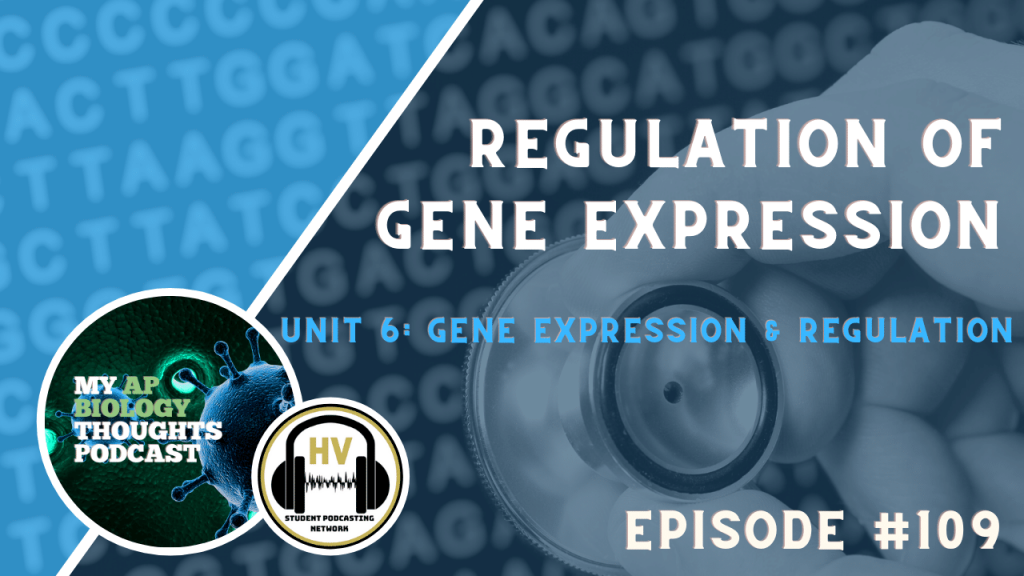Regulation of Gene Expression

My AP Biology Thoughts
Unit 5 Heredity
Welcome to My AP Biology Thoughts podcast, my name is Helena Holley and I am your host for episode #109 called Unit 6 gene expression and regulation: Regulation of gene expression. Today we will be discussing the mechanism of gene expressions and regulation in Eukaryotes and Prokaryotes.
Segment 1: Introduction to Gene Expression and Regulation
Gene expression and its regulation and control is essential for cell specialization in Eukaryotes. All cells have the same information, however their differences in function come from which genes they express. As you go through development cells are differentiated. The way this happens is by specific transcription factors and translation controls that tell the cells which genes they are expressing as you develop. Your basic genetics are not the only thing that determines which genes are expressed, epigenetics also plays a role. Certain environmental factors that occur in a parents lifetime can alter the gene expression of offspring. This happens when there are changes in the parents’ cells that undergo meiosis to produce gametes. Examples of this include DNA methylation and histone modification. While I was just discussing eukaryotes above, gene expression and regulation is also important in prokaryotes, which I will discuss more later.
Segment 2: More About Gene Expression and Regulation
There are various ways in which gene expression is regulated in Eukaryotes. One regulation method is determined by how tightly DNA is wrapped around Histone proteins. The tighter the DNA is wrapped, the harder it is for transcription to take place, and certain enzymes can alter how tight or loose it is wrapped depending on what needs to happen. There are also chromatin-modifying enzymes that can make the DNA more or less accessible. Another regulatory factor is the Control elements which are regulatory sequences on DNA that control the expression of proteins. Alternative RNA splicing helps to regulate post transcription, as it produces different mRNA from the same gene. Another useful method is mRNA degradation which is used to break down mRNA if the protein is not needed to be expressed anymore. Finally, various regulatory proteins can block initiation of translation if that is needed. It is important to note that mRNA is not the only type of RNA used for regulation, and there are various types of non-coding RNA that have different functions in regulation of gene expression. In prokaryotes there are repressible and inducible operons. The repressible operon genes are able to be silenced, and the inducible operon genes are able to be turned on. This function of these operons is important in gene regulation because if a repressible operon is absent, the repressor is inactive and the operon will be produced. When too much of a repressible operon is in the cell, it will bind to the repressor which will bind to the operator, preventing any more from being produced. For inducible operons, the process works essentially the opposite of the repressible operons (so briefly the repressor is active when there is an absence of lac operon, and it is inactive when there is presence lac operon).
Segment 3: Connection to the Course
Gene expression and regulation is important because any errors in regulation can lead to developmental problems. For example, If the tumor suppressor gene is silenced due DNA methylation occurring in the parent, the offspring would be very susceptible to cancer and disease. Another reason why the regulation of expression of genes is important is because not having all genes turned on all the time, conserves a lot of energy and space. It is a lot more efficient to only turn on genes when they are required. Additionally, if every gene was being expressed, cells would have to be much larger because DNA has to be unwound in order to transcribe and translate it.
Thank you for listening to this episode of My AP Biology Thoughts. For more student-ran podcasts and digital content, make sure that you visit www.hvspn.com. (for your children’s sake, maybe don’t go explore the radiation danger zone)!
Music Credits:
- “Ice Flow” Kevin MacLeod (incompetech.com)
- Licensed under Creative Commons: By Attribution 4.0 License
- http://creativecommons.org/licenses/by/4.0/
Subscribe to our Podcast
Connect with us on Social Media
Twitter @thehvspn

